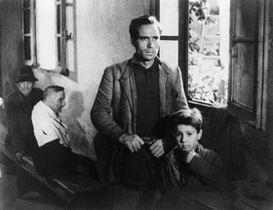Best 10 Most Influential Movies of the 40s
20.05
Diposting oleh Melany Christy
10) The Bicycle Thief (1948)
 – in a post-war torn Italy comes Vittorio de Sica’s Ladri di Biciclette (The Bicycle Thief), a riveting and vastly gritty study in survivalist realism. Balancing the delicate topics of a relationship between father and son and the importance of survival during difficult times, The Bicycle Thief is an example of how film should reflect the truth no mater how gritty it might be.
– in a post-war torn Italy comes Vittorio de Sica’s Ladri di Biciclette (The Bicycle Thief), a riveting and vastly gritty study in survivalist realism. Balancing the delicate topics of a relationship between father and son and the importance of survival during difficult times, The Bicycle Thief is an example of how film should reflect the truth no mater how gritty it might be.
9) Treasure of the Sierra Madre (1948)

– John Huston’s chilling and realistic cinematic depiction of greed in the wilderness of Mexico, The Treasure of the Sierra Madre, is an effective mix of different genres, mostly inspired in the vein of the western, and despite its historical limitations has quite the undying message about man’s selfishness and brutal tendencies. Huston was able to capture the dry and unforgiving scenery quite accurately, which reinforced the phenomenal performances from Humphrey Bogart, Tim Holt, and Walter Huston.
8 The Great Dictator (1940)

– The Great Dictator was the socially conscious comedy from the renowned actor and director Charlie Chaplin and was his first film that contained dialogue. Taking on the task of mocking Hitler and the German fascist movement, Chaplin put himself in the limelight as an artist willing to take risks and in the end made a production that was astoundingly ahead of its time.
7) It’s a Wonderful Life (1946)

– practically the only holiday film worth watching over and over again, Frank Capra’s It’s a Wonderful Life is the moral tale about George Bailey, in a natural and emotional performance from Jimmy Stewart, that widely embraces the idea that cherishing what you have rather than what you want is a key to understanding happiness. The very fact that this film is played every year around Christmas is a testament to its timeless message and its long lasting quality as a film.
6) The Grapes of Wrath (1940)

– the unforgettable adaptation of John Steinbeck’s finest piece of literary work was safe in the hands of John Ford who made The Grapes of Wrath an eloquent spectacle of survival, family, and hardship. Ford’s delicate handling on the subject of family has been one of his strengths throughout all his films and The Grapes of Wrath is probably his finest attempt, utilizing the remarkable Henry Fonda as the pivotal character that brings this fine piece of cinema together.
5) The Maltese Falcon (1941)

– John Huston’s The Maltese Falcon is a one of a kind detective murder mystery that deals with the essence of right and wrong as well as some distinct human characteristics such as greed and disloyalty which seem to be ingrained in all of us. With marvelous pacing and finely tuned directing, The Maltese Falcon is as enjoyable as it is a symbol for classic filmmaking (It’s the stuff dreams are made of).
4) The Third Man (1949)

– Carol Reed’s The Third Man is a beautifully dark and thought provoking mystery thriller that was vastly ahead of its time in the vein of cinematography using a very dark and bleak photography that only accentuated its exceptionally twisted storyline. It’s an engaging piece of cinema that is incredibly artistic and quite modern in its technical delivery, especially in the epic and nerve wracking chase scene in the sewers of Vienna.
3) Double Indemnity (1944)

– the mystery insurance scam noir Double Indemnity is a twisted tale of lust, greed, and murder that engages the audience using a hapless and tragic anti-hero. Billy Wilder tightly directs this difficult and mature thriller exceptionally well, with out of character performances from Frank MacMurray and Edward G. Robinson, and is an unparalleled example of the artistic credibility the noir genre has to offer.
2) Casablanca (1942)

– the cinematically iconic Casablanca is director Michael Curtiz’s masterpiece about love and loss, utilizing perfect performances from Humphrey Bogart and Ingrid Bergman that only aids to the brilliant and effective screenplay. Consistently referred to as “the film you’ve seen even if you haven’t seen it” shows just how pertinent and influential it has been to cinema and is rewarded for its contribution by sitting in the third position on the AFI top 100 films list.
1) Citizen Kane (1941)

– Orson Welles’ non-linear narrative about greed, power, and loss, was the most technically innovative film to come out of the 40s and practically defined the modern method of filmmaking. Citizen Kane was a social critique that used ingenuity, expressive lighting, and phenomenal acting that has critics all over claiming it to be the finest film ever made sitting at the top position on the AFI top 100 films list.
Honorable Mentions (in no particular order): How Green Was My Valley, Notorious, The Best Years of Our Lives, The Magnificent Ambersons, The Shop Around the Corner, Henry V, The Big Sleep, Fantasia, Red River, and Rebecca.
Posting Komentar